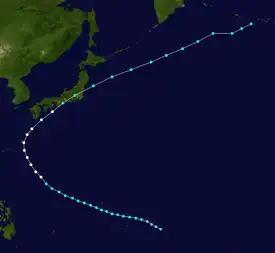 | |
| Meteorological history | |
|---|---|
| Formed | September 10, 1945 |
| Dissipated | September 20, 1945 |
| Category 1-equivalent typhoon | |
| 1-minute sustained (SSHWS) | |
| Highest winds | 130 km/h (80 mph) |
| Lowest pressure | 917 hPa (mbar); 27.08 inHg |
| Overall effects | |
| Fatalities | 2,473 |
| Missing | 1,283 |
| Areas affected | Japan, China, Russia Far East, Kuril Islands, Guam |
| IBTrACS | |
Part of the 1945 Pacific typhoon season | |
Typhoon Ida, known in the Japan as Makurazaki Typhoon (枕崎台風),[1][2] was a powerful and very deadly typhoon which hit Japan in 1945, causing over 2,000 deaths. The main cause for the number of fatalities is due to the atomic bombings of Hiroshima which had occurred just one month prior, resulting in further devastation to the already destroyed city. The typhoon likely had much higher wind speeds than current estimates place it with a minimum pressure of 917 millibars, however scientists are uncertain on the storm's true intensity. Nonetheless, the storm became one of the deadliest in Japanese history and is one of few storms to be given a separate Japanese name.
Meteorological history

Tropical storm (39–73 mph, 63–118 km/h)
Category 1 (74–95 mph, 119–153 km/h)
Category 2 (96–110 mph, 154–177 km/h)
Category 3 (111–129 mph, 178–208 km/h)
Category 4 (130–156 mph, 209–251 km/h)
Category 5 (≥157 mph, ≥252 km/h)
Unknown
A tropical depression had formed in the West Pacific on September 10 and would intensify before being designated as Typhoon Ida. Ida would continue to slowly move westwards, and after beginning to curve north would likely rapidly intensify into a powerful typhoon. Ida would then make landfall near Makurazaki in Kagoshima Prefecture on September 17.[1] Ida was the strongest typhoon to hit Kyushu on record, with a minimum sea-level pressure of 916.1 hPa (27.05 inHg) and a maximum wind gust of 62.7 metres per second (140 mph), which was recorded at a weather station in Makurazaki.[3] This reading makes the storm responsible for the second lowest pressure ever recorded in mainland Japan, after the 1934 Muroto typhoon.[2][1][4] After passing through Japan, Ida would then move northeast and weaken, before then likely turning extratropical and dissipating near the western Aleutian islands on September 20.
Impact and Aftermath
More than 2,000 people were killed in the Hiroshima Prefecture after heavy rains brought by a weakening Ida caused severe landslides.[5][1][6] The storm occurred just days after Japan surrendered after the Pacific War, and the damage caused by Ida worsened the situation.[1][6]
In addition, USS Repose (AH-16) reportedly entered Ida's eye and observed winds of 175 miles per hour and an atmospheric pressure of 25.55 inches of mercury (about 865 hPa).[7][8][9] This is below the Typhoon Tip (870 hPa) in 1979, the official world record for minimum sea level pressure, although this data is not confirmed.
References
- 1 2 3 4 5 "枕崎台風 昭和20年(1945年) 9月17日~9月18日". www.data.jma.go.jp (in Japanese). Retrieved 2020-08-08.
- 1 2 第三版,日本大百科全書(ニッポニカ), ブリタニカ国際大百科事典 小項目事典,朝日新聞掲載「キーワード」,デジタル大辞泉,百科事典マイペディア,世界大百科事典 第2版,大辞林. "枕崎台風(まくらざきたいふう)とは". コトバンク (in Japanese). Retrieved 2020-08-08.
{{cite web}}: CS1 maint: multiple names: authors list (link) CS1 maint: numeric names: authors list (link) - ↑ Weather Records of Makurazaki Japan Meteorological Agency
- ↑ "バイオウェザー・お天気豆知識". www.bioweather.net. Retrieved 2020-08-08.
- ↑ Makurazaki typhoon Hiroshima disaster prevention Web Archived 2017-07-14 at the Wayback Machine Hiroshima Prefectural Government
- 1 2 "Peace Seeds ヒロシマの10代がまく種(第16号) 終戦直後を襲った「枕崎台風」". ヒロシマ平和メディアセンター (in Japanese). Retrieved 2020-08-08.
- ↑ 講談社『ギネスブック 世界記録事典 1980』90頁の他、1981年度版、1982年度版等にも記載があるが、865hPaではなく856hPaとなっている。
- ↑ "Repose newspaper page 1". 2001-09-09. Archived from the original on 2001-09-09. Retrieved 2020-08-08.
- ↑ "REPOSE (Page 1)". 1998-12-05. Archived from [members.aol.com/chuckd3871/repose1.htm the original] on 1998-12-05. Retrieved 2020-08-08.
{{cite web}}: Check|url=value (help)